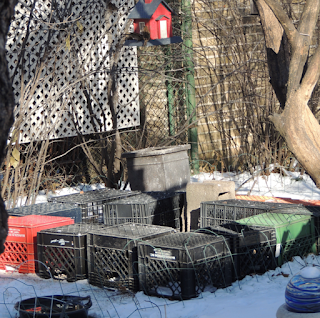There has been a lot of criticism recently of
people who allow cats to roam outdoors. Books such as Peter Marra's Cat
Wars: The Devastating Consequences of a Cuddly Killer do make a point.
Roaming cats are clearly responsible for the deaths of many birds and members
of other valuable wildlife species.
This new emphasis on the harm done by outdoor cats
flies in the face of a lot of trap/neuter/release programs that have been
started around the U.S. as a way of putting feral cats to work controlling
rodent populations. I myself was the guardian of a feral colony in Chicago.
When my neighbor complained about the presence of roaming cats in her yard, I
oriented several of the cats to greater domesticity. But it's very hard to
re-condition alley cats to be satisfied staying indoors all the time. My cats
still use a pet door to spend some time in my yard almost every day. Attempts
at blocking off that pet door led to ferocious clawing, squalls, bad temper,
and persistent, destructive efforts at escape.
However, I have felt a little less guilty about
allowing my cats to continue some roaming behavior after I read an excerpt from
Charles Darwin's On the Origin of Species. In an early chapter of that
1859 ground-breaking work, Darwin says:
The murder of humble-bees in any district depends
in a great degree on the number of field-mice, which destroy their combs and
nests... Now the number of mice is largely dependent, as every one knows, on
the number of cats; and Mr. Newman says, “Near villages and small towns I have
found the nests of humble-bees more numerous than elsewhere, which I attribute
to the number of cats that destroy the mice.” Hence it is quite credible that
the presence of a feline animal in large numbers in a district might determine,
through the intervention first of mice and then of bees, the frequency of
certain flowers in that district! (Darwin and others of that era referred to
bumblebees as “humble-bees.”)
Researching this matter a little further, I found
a lot of people in the Victorian era had made a similar association between the
presence of sufficient numbers of roaming cats and the flourishing of their
gardens. In the rather sexist terms of that era, people would lament the
scarcity of “old maids.” That's because old maids were famous for keeping cats.
No old maids, no cats. No roaming cats and the rodent population exploded. An
exploding rodent population meant the destruction of bees' nests and therefore a
failure of flowers and crops to be sufficiently cross-pollinated.
I don't seriously think that an insufficiency of
feral cats is behind the collapse of bee populations around the world. However,
in helping to control rodent populations, feral cats might at least play a
small role in helping bees survive to do their vital work.
Incidentally, my cats DO control the rodent
population. They kill not only mice, but large rats. People have doubted that
cats will tackle hefty rats, but I can attest that my cats are lethal to even
the biggest neighborhood rats.
However, after having had my conscience salved a
little by reading Darwin's affirmation of the need for roaming cats, I was
still left with the fact that my cats were killing as many as 3-4 birds a week
that they caught around my bird-feeders. But I might have finally come up with
an effective way of greatly reducing the risk to birds.
Nothing I commonly saw recommended worked. No bell
collars, colorful clown collars, or typical fences, prevented my cats from
catching birds unaware. But – Eureka! I have found an answer that seems to
have cut down bird fatalities at my bird-feeders by about 90%. The answer is
milk crates!
I collected a number of milk crates, the kind that
have the open lattice-work bases. I kept in place the low wire fence I had put
around the area under my bird-feeders. But inside that “compound,” I upended a
dozen or more milk crates. The wire fence by itself did almost nothing to slow
down my cats' attacks. But the cats absolutely cannot negotiate on top of or
around the massed milk crates. However, the birds can easily perch on top of
the plastic cross-pieces on these crate bottoms. And they can easily forage
between the crates for dropped birdseed. These crates can be moved in seconds
so that I can gain access to the bird-feeders to regularly re-fill and clean
them.
Below is a picture of the crates I've positioned
under my feeder. Given a little more time, I can collect or buy a more
attractive array of crates, possibly even creating a tiered, multi-colored
effect with them. Without getting too kitschy, I might also use the crates'
plastic lattice-work as supports for real or artificial flowers. By decorating
the crates with flowers, I would be making it even more difficult for the cats
to negotiate their surfaces, and I'd be making a colorful display that would
attract more birds and make the arrangement more visually appealing to
neighbors. A person could exercise no end of creativity grouping milk crates
into attractive landscape structures.
